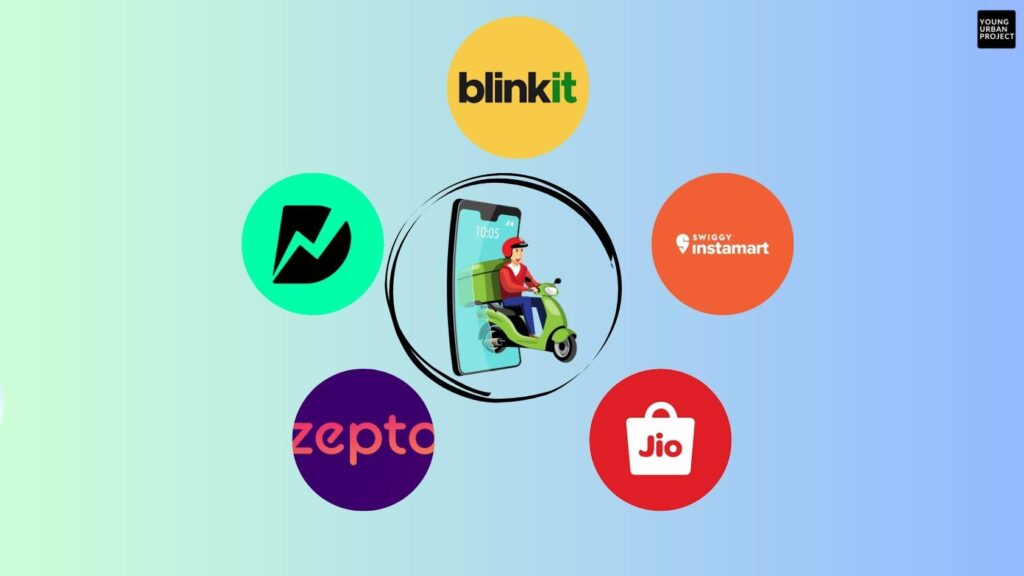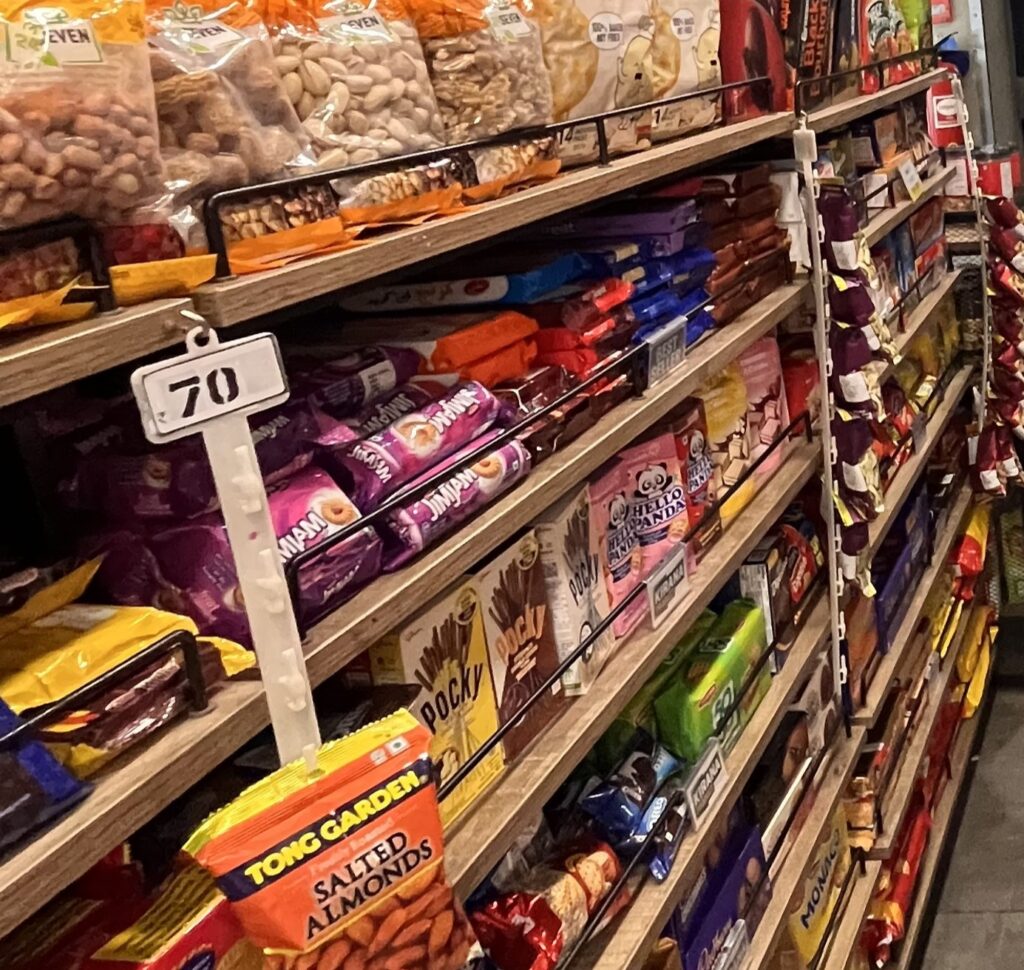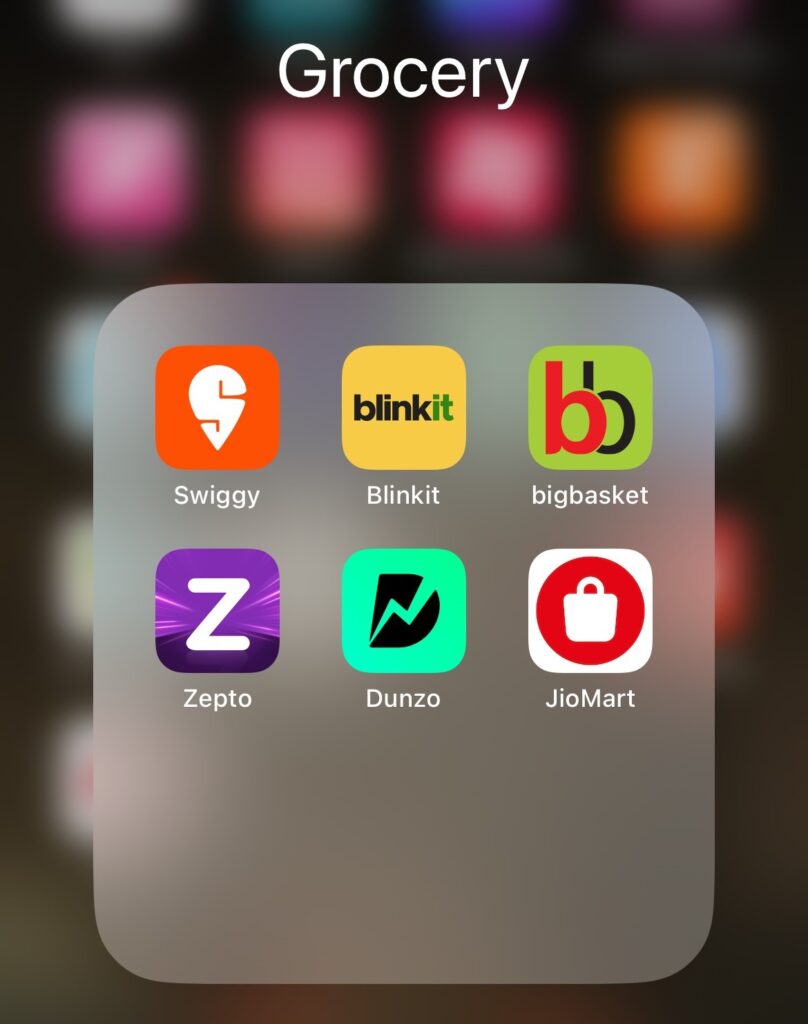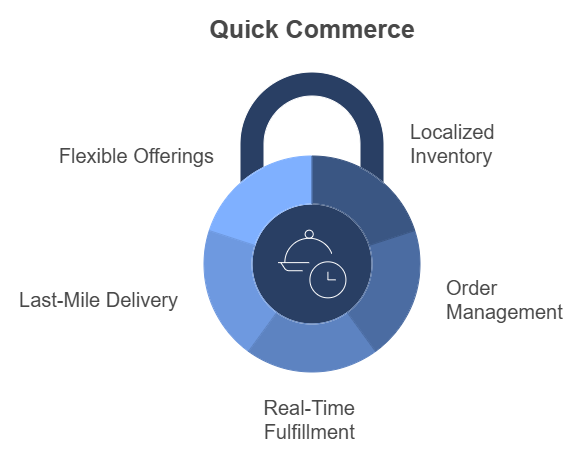Some 5-6 years ago, when you used to crave Maggi at night and notice you ran out of it, you would just go to sleep and wait for the next day to get it. But things are different now with Blinkit, Zepto, and Instamart. With just a few taps, it’s at your doorstep in under 15 minutes. This is the era of quick commerce, a sector that’s rapidly rewriting the rules of online retail.
India’s Q-Commerce industry is valued at an estimated USD 3.34 billion in 2024 and is projected to grow to USD 9.95 billion by 2029, with a CAGR exceeding 4.5% during the forecast period (2024-2029). These numbers aren’t just statistics; they’re proof of a retail revolution that’s reshaping how we shop, consume, and live.
But what is quick commerce? How did it come to dominate India’s e-commerce space so quickly? Let’s dive deep into the world of q-commerce, its implications, and its potential future.
Table of Contents
What is Quick Commerce?

Quick commerce, often referred to as q-commerce, is a new-age e-commerce model designed to deliver products at lightning speed. Think of it as e-commerce 2.0—hyperlocal, fast, and ultra-convenient.
Unlike traditional e-commerce platforms that take hours or days to deliver, quick commerce promises deliveries in as little as 10-30 minutes, focusing on small-sized orders like groceries, personal care items, and daily essentials.
The backbone of this model? Advanced logistics, dark stores (small fulfillment centers), and a hyperlocal delivery network that operates with clockwork precision.
The main appeal lies in its ability to cater to the “I-need-it-now” mentality of urban consumers who value time and convenience above all else.
Difference Between Q-Commerce and E-Commerce
While q-commerce is an offshoot of e-commerce, the two models differ significantly.
| Aspect | E-Commerce | Q-Commerce |
| Delivery Time | 1 day to several days | 10-30 minutes |
| Order Size | Large orders | Small, frequent orders |
| Focus Areas | Electronics, fashion, bulk items | Groceries, daily essentials |
| Logistics | Regional/national warehouses | Hyperlocal dark stores |
| Target Audience | Planners | Impulse buyers |
Difference between Traditional Food delivery services and Quick Commerce
| Aspect | Traditional Food Delivery | Quick Commerce |
| Definition | Delivering prepared meals from restaurants. | Delivering groceries, essentials, or meals in 10-20 minutes. |
| Delivery Time | Typically 30-60 minutes. | Ultra-fast, usually within 10-20 minutes. |
| Focus | Restaurant-prepared food. | Both essentials and ready-to-eat food. |
| Target Audience | Consumers seeking restaurant-quality meals. | Consumers needing quick meals or everyday items. |
| Logistics Model | Relies on restaurant partnerships and delivery riders. | Operates through micro-warehouses or dark stores. |
| Examples | Swiggy, Zomato | Zepto, Blinkit, Swiggy Instamart. |
| Order Size | Smaller, typically a single meal. | Smaller but includes groceries or snacks alongside food. |
| Use Case | Satisfying meal cravings from restaurants. | Meeting urgent needs, including quick meals or essentials. |
The Evolution of Quick Commerce in India
India’s journey into the world of quick commerce is a fascinating tale of necessity, innovation, and the adaptation of global trends to local needs. From its humble beginnings to becoming a multi-billion-dollar industry, q-commerce in India has experienced a rapid and transformative evolution. Let’s explore its progression step by step.
1. The E-Commerce Foundation
The evolution of q-commerce in India is deeply rooted in the success of traditional e-commerce. Giants like Flipkart, Amazon, and Snapdeal revolutionized how Indians shopped by introducing online platforms that delivered products to their doorsteps.
However, e-commerce had its limitations:
- Delivery times typically ranged from 1 to 7 days, which didn’t suit urgent needs.
- Bulk purchases dominated the landscape, sidelining smaller, frequent orders.
While e-commerce addressed convenience for planned purchases, the lack of immediacy left a gap for impulse buying and urgent requirements—setting the stage for quick commerce.
Enroll Now: Performance Marketing Training
2. The Rise of Hyperlocal Delivery
Before q-commerce became mainstream, India saw the emergence of hyperlocal delivery platforms such as:
- Dunzo (2014): Started as an errand service, Dunzo soon ventured into delivering groceries, medicines, and other essentials.
- Swiggy and Zomato: Although primarily food delivery platforms, they played a significant role in familiarizing Indian consumers with ultra-fast delivery models.
These services demonstrated the potential of hyperlocal logistics, making customers comfortable with the idea of getting items delivered within minutes.
3. COVID-19 as a Catalyst
The COVID-19 pandemic in 2020 was a turning point for quick commerce in India. Nationwide lockdowns forced people indoors, leading to skyrocketing demand for home-delivered groceries and essentials.
Key developments during this period:
- New Consumer Expectations: With restricted movement, speed became a critical factor in purchasing decisions.
- Dark Stores and Micro Warehouses: Companies set up small, strategically located fulfillment centers to cater to hyperlocal needs.
- Adoption of Digital Payments: The pandemic accelerated the adoption of digital payment platforms like UPI, further simplifying transactions in q-commerce.
Companies like BigBasket, Blinkit (formerly Grofers), and Swiggy Instamart saw an unprecedented surge in orders, paving the way for q-commerce to emerge as a distinct sector.
4. The Entry of Dedicated Q-Commerce Players
Post-pandemic, India witnessed the arrival and rise of players dedicated solely to q-commerce:
- Blinkit (2021): Rebranded to align with its promise of 10-minute deliveries, Blinkit became synonymous with speed in the grocery delivery space.
- Zepto (2021): A startup that raised millions in funding, Zepto built its reputation on ultra-fast delivery and an aggressive expansion strategy.
- Swiggy Instamart: Leveraging its food delivery network, Swiggy diversified into quick commerce, offering groceries and essentials in record time.
These companies invested heavily in technology, logistics, and customer acquisition, driving exponential growth in the sector.
5. Urbanization and Lifestyle Shifts
India’s rapid urbanization and changing consumer behavior also played a pivotal role in the evolution of quick commerce.
Key Factors Driving Adoption:
- Time-Poor Consumers: With longer working hours and urban commutes, consumers in metro cities like Mumbai, Delhi, and Bengaluru began prioritizing convenience over cost.
- Increased Smartphone Penetration: With over 1 Billion smartphone users in India, app-based services became accessible to a vast audience.
- The Rise of Millennials and Gen Z: Younger generations, known for their impatience and tech-savviness, readily embraced the concept of 10-minute deliveries.

Enroll Now: Advance Product Marketing Course
6. Tech-Driven Innovations
The backbone of quick commerce in India is its reliance on technology. Advanced algorithms, AI-driven inventory management, and real-time route optimization have transformed logistics into a finely tuned machine.
Examples of Innovations:
- Predictive Analytics: Q-commerce companies use AI to predict consumer demand and ensure high-demand items are stocked in dark stores.
- Dynamic Delivery Routes: GPS and AI-based routing systems minimize delivery times.
- Personalized Experiences: Data analytics allows companies to offer tailored recommendations to customers, boosting order frequency.
7. Investor Confidence and Funding
The q-commerce boom attracted billions of dollars in funding, fueling growth and innovation. Some notable investments include:
- Zepto: As of 2024, Zepto has raised a total funding of $1.6 billion over 9 rounds
- Blinkit: Blinkit has raised a total funding of $757M over 15 rounds.
- Dunzo: Dunzo has raised a total funding of $449M over 18 rounds.
- Swish: Recently, Bengaluru-based 10-minute food delivery startup Swish raised $2M in its first funding round, led by Accel, with participation from angel investors like Urban Company founders and ex-Swiggy Instamart head.
This influx of capital has allowed players to expand into new cities, enhance tech infrastructure, and refine delivery processes.
8. Expansion Beyond Metro Cities
Initially, quick commerce was concentrated in Tier-1 cities like Mumbai, Delhi, and Bengaluru. However, with growing demand, companies began penetrating Tier-2 and Tier-3 cities.
Challenges and opportunities in smaller cities:
- Challenges: Lower order volumes and less dense populations make logistics trickier.
- Opportunities: Less competition and a growing middle-class population eager for convenience.
9. Partnerships with Kirana Stores
To scale operations and gain hyperlocal insights, many Q-commerce platforms partnered with Kirana stores (traditional mom-and-pop shops). This symbiotic relationship:
- It helps Kiranas digitize their inventory and access a broader customer base.
- Enables q-commerce companies to expand without significant infrastructure costs.
10. Competitive Landscape and Differentiation
The evolution of q-commerce in India has also been shaped by fierce competition. Companies constantly innovate to stand out, focusing on:
- Faster Delivery Times: From 30 minutes to a bold promise of 10 minutes.
- Wider Product Range: Offering not just groceries but also OTC medicines, household essentials, and even personal care items.
Loyalty Programs: Encouraging repeat purchases through discounts and subscription models.
Also read: Mastering B2B Lead Generation
How Kirana Stores In India Have Been Affected

India’s beloved kirana stores (mom-and-pop shops) have been the backbone of retail for decades. But q-commerce is disrupting this space.
A Datum report shows that Kirana stores’ market share decreased from 95% in 2018 to 92.6% in 2023, with projections indicating a further decline to 88.9% by 2028.
Challenges Faced by Kiranas
- Decline in Foot Traffic: With quick commerce offering ultra-fast deliveries, fewer customers visit kiryana stores for small, urgent needs.
- Price Competition: Q-commerce players often offer discounts that small kiranas struggle to match.
- Tech Gap: Most kiranas lack the digital infrastructure to compete with q-commerce platforms.
Opportunities for Kiranas
But it’s not all gloom. On the bright side many kiranas are partnering with q-commerce platforms, acting as micro-fulfillment centers. This symbiosis allows them to expand their customer base while leveraging Q-commerce’s tech and logistics.
How Quick Commerce Has Affected E-Commerce
The rise of quick commerce has significantly reshaped the landscape of traditional e-commerce. Q-commerce focuses on ultra-fast deliveries, typically within 10 to 30 minutes, catering to consumers who demand near-instant gratification. This shift has not only disrupted food delivery services but is now extending its influence to broader sectors, including grocery and electronics.
Here are the key ways in which quick commerce is affecting e-commerce:
1. Changing Consumer Expectations
With the advent of q-commerce, consumers now expect much faster delivery times, pushing e-commerce companies to rethink their logistics models. Traditional e-commerce, which typically promises delivery within 1-3 days, is now competing with q-commerce’s speed. Companies are increasingly pressured to offer same-day or even instant deliveries to stay relevant.
Example: E-commerce giants like Flipkart have ventured into the quick-commerce space with services like Flipkart Minutes, aiming to deliver products such as electronics and groceries within 10-15 minutes. Similarly, platforms like Zepto, Blinkit, and Swiggy’s Instamart are capitalizing on this trend to cater to the growing demand for faster service.
2. Reinventing Last-Mile Delivery
Quick commerce has revolutionized last-mile delivery, a traditionally challenging part of e-commerce. By utilizing dark stores (mini-warehouses in local areas), q-commerce companies reduce delivery times and minimize logistical costs. This has forced traditional e-commerce players to invest more in localized warehouses, automated supply chains, and technology-driven solutions to stay competitive.
Example: Swish, a food delivery startup, uses specialized cloud kitchens in Bengaluru, cutting delivery time to 10 minutes by optimizing their operations for speed and precision.
3. Impact on Inventory and Product Range
Quick commerce has influenced how companies manage their inventory. To meet the demands of ultra-fast delivery, companies often prioritize high-turnover products. This has led to the rise of highly localized, curated product selections, as opposed to the vast catalogs seen in traditional e-commerce.
While traditional e-commerce platforms like Amazon or Flipkart still offer an extensive array of products for longer delivery windows, quick commerce focuses on delivering a smaller but high-demand product range. This has led to a segmentation in e-commerce, with traditional platforms focusing on larger purchases and q-commerce focusing on everyday essentials.
4. Rising Competition and Mergers
As quick commerce continues to gain ground, it has led to increased competition in the e-commerce space, particularly with hyperlocal delivery services. This has prompted traditional e-commerce platforms to adopt a hybrid approach, combining same-day delivery with their traditional logistics models.
Some of the mergers and partnerships in the sector reflect this shift. For instance, Zomato acquired Blinkit, and Swiggy continues to expand its Instamart service, while Amazon has introduced Prime Now for rapid grocery deliveries. These efforts are direct responses to the growing influence of quick commerce and its ability to capture consumer attention.
5. New Revenue Streams
Q-commerce has opened up new revenue streams for e-commerce platforms, particularly in the grocery, pharmacy, and electronics sectors. Companies are capitalizing on the rise in impulse buying and consumers’ willingness to pay extra for faster service. In addition to traditional e-commerce, q-commerce is becoming an important supplementary service for platforms looking to diversify.
Example: Companies like BigBasket (BB Now) and Grofers have expanded into grocery quick commerce, further blurring the lines between traditional and quick commerce. These companies are competing directly with e-commerce giants who are seeking to retain market share in the rapidly evolving space.
Quick Commerce Companies in India

1. Blinkit (Formerly Grofers)
Founded: 2013
USP: 10-minute delivery for essentials
Key Backers: Zomato
Journey and Impact:
Blinkit, initially launched as Grofers, was one of the pioneers in India’s online grocery delivery space. The company underwent a major rebranding in 2021 to align itself with the rising demand for quick commerce. By focusing on 10-minute deliveries, Blinkit positioned itself as a leader in the q-commerce sector.
- Technology Integration: Advanced inventory management and hyperlocal logistics ensure customers receive deliveries in minutes.
- Product Range: Offers groceries, household items, personal care products, and more.
- Zomato Integration: After Zomato acquired a majority stake in 2022, Blinkit expanded its reach and gained a competitive edge.
Blinkit operates heavily in metro cities like Delhi, Mumbai, and Bengaluru, where its promise of speed and convenience resonates with urban consumers.
2. Zepto
Founded: 2021
USP: Focus on young urban consumers and 10-minute delivery model
Key Backers: Y Combinator, Nexus Venture Partners
Journey and Impact:
Founded by two teenagers, Zepto is a shining example of how quick commerce has captured the imagination of India’s younger entrepreneurs. The company has grown rapidly, securing millions in funding and becoming a top player in the industry.
- Dark Store Model: Zepto has strategically located fulfillment centers that allow it to fulfill its ultra-fast delivery promise.
- Tech-Driven Operations: The company uses AI to predict demand and stock high-demand products efficiently.
- Youth-Centric Branding: Its branding resonates with millennial and Gen Z consumers, who prioritize convenience and immediacy.
Zepto operates in over 10 cities, including Pune, Hyderabad, and Chennai, and plans to expand aggressively in the near future.
3. Swiggy Instamart
Launched: 2020
USP: Backed by Swiggy’s vast delivery network
Key Backers: Prosus Ventures, SoftBank
Journey and Impact:
Swiggy, India’s leading food delivery platform, ventured into q-commerce with the launch of Swiggy Instamart. The brand leverages Swiggy’s existing infrastructure to deliver groceries and essentials in 15-30 minutes.
- Wide Reach: Operates in over 25 cities, making it one of the largest players in the segment.
- Partnership with Local Stores: Collaborates with kirana stores to expand its inventory and improve delivery times.
- Strong Brand Trust: Swiggy’s established reputation in food delivery gives Instamart a competitive edge.
Swiggy Instamart’s strength lies in its ability to integrate seamlessly into Swiggy’s app, encouraging cross-category purchases and customer retention.
4. BigBasket (BB Now)
Launched: 2021
USP: Trusted name in online grocery delivery with a quick commerce segment
Key Backers: Tata Group
Journey and Impact:
BigBasket, a household name in e-grocery, introduced BB Now to cater to the growing demand for faster deliveries. With the backing of the Tata Group, BB Now focuses on offering 30-minute deliveries for everyday essentials.
- Inventory Management: Combines dark stores with BigBasket’s existing supply chain to ensure product availability.
- Wide Customer Base: Benefits from BigBasket’s loyal customer base and reputation for quality.
- Product Range: BB Now offers over 30,000 SKUs across categories, ensuring something for everyone.
BB Now’s ability to blend speed with BigBasket’s trust factor makes it a formidable player in the q-commerce space.
5. Dunzo
Founded: 2014
USP: Multi-utility platform offering everything from groceries to medicines
Key Backers: Reliance Retail, Google
Journey and Impact:
Dunzo started as a hyperlocal delivery service but quickly evolved into one of India’s top q-commerce companies. Its flexibility and ability to deliver almost anything within minutes set it apart.
- Diverse Offerings: In addition to groceries, Dunzo delivers medicines, documents, and even packages.
- Partnerships with Kirana Stores: Collaborates with local shops to strengthen its inventory.
- Funding Boost: Recent investments from Reliance Retail have fueled its expansion into new markets.
Dunzo is particularly popular in cities like Bengaluru and Pune, where its reliability and speed have made it a household name.
6. Reliance JioMart
Launched: 2021
USP: Leveraging Reliance’s extensive retail network
Key Backers: Reliance Industries
Journey and Impact:
JioMart Express is the quick commerce arm of Reliance JioMart, combining Reliance Retail’s extensive network with hyperlocal delivery capabilities.
- Wide Network: Benefits from Reliance’s physical stores and supply chain.
- Integration with Jio Ecosystem: Works seamlessly with Jio platforms, offering added benefits to Jio users.
- Competitive Pricing: Reliance’s financial strength allows it to offer competitive prices, challenging other players.
JioMart Express is particularly focused on smaller towns and cities, aiming to bring q-commerce to India’s underserved regions.
7. Flipkart Minutes
Launched: August 2024
USP: Rapid delivery of electronics and everyday essentials in 10–15 minutes
Key Backers: Walmart
Journey and Impact
Flipkart has made a decisive move into quick commerce with its newly launched service, Flipkart Minutes. This service positions the company in direct competition with existing players like Zepto, Swiggy’s Instamart, and Blinkit. Flipkart Minutes caters to high-demand residential and IT hubs with deliveries within 10–15 minutes.
Strategy and Expansion
To support its quick commerce ambitions, Flipkart plans to establish around 100 fulfillment centers, ensuring efficient stock management and faster order processing. While its same-day delivery services cover millions across metro and non-metro cities like Bhubaneswar, Coimbatore, and Patna, Flipkart Minutes takes speed to the next level by targeting hyperlocal delivery needs.
Product Range and Differentiation
Flipkart Minutes stands out by offering not just groceries but also electronics and smartphones in the quick commerce category, addressing unique consumer needs. This sets it apart from competitors primarily focused on daily essentials.
6. Swish
Launched: 2024
USP: 10-minute delivery of food through ‘delight centers’
Key Backers: Accel
Journey and Impact
Swish, a new player in the food delivery market, is disrupting the space with its bold promise of delivering food within 10 minutes. Based in Bengaluru, Swish has made a name for itself with its hyper-efficient food delivery model and the launch of its ‘delight centres’—specialized cloud kitchens that are optimized for speed and quality. These centres are the backbone of Swish’s operations, designed to minimize prep and delivery times to ensure that customers get their meals almost immediately after ordering.
With a $2 million seed round led by the Accel venture capital firm, Swish has attracted significant investor interest, positioning itself as a major contender in the fast-growing quick commerce market in India. This funding will help Swish expand across Bengaluru and eventually into other key cities by March 2025, with plans to open 150 delight centres to meet demand.
Strategy and Expansion
Swish’s model is centered on optimizing delivery routes and reducing wait times through cloud kitchens that are strategically located within a 1.5-2 km radius of key customer areas. This allows them to meet their 10-minute delivery promise. Critics, however, have raised concerns about the feasibility of maintaining food quality and the safety of delivery personnel, which Swish addresses through its streamlined operations.
The company’s plans are ambitious—150 delight centers in just one year—and demonstrate a commitment to pushing the boundaries of what’s possible in the hyperlocal food delivery space. As Swish scales, the goal is to tap into the $40 billion quick commerce market projected by 2030.
Product Range and Differentiation
Swish’s focus is on speed without compromising quality, aiming to deliver fresh food at lightning speed. Their specialized cloud kitchens are designed for efficiency, allowing for quick preparation and fast dispatch of food, with a particular focus on popular local cuisines that can be delivered swiftly.
Industry Impact
Swish’s entry into the 10-minute delivery space is in direct competition with established players like Swiggy and Zomato, who have already cemented their positions in the food delivery landscape. However, Swish is betting on its ability to deliver food faster than its rivals while maintaining quality, a combination that could disrupt the market.Industry analysts are noting that Swish’s move taps into the growing consumer desire for immediacy, as evident from the wider trend in quick commerce, where companies like Zepto are expanding into new categories like café items. The market’s embrace of instant gratification could provide Swish with a solid foundation for growth.
Also read: What is Product Mix? Strategies and Examples for Growth
Advantages of Quick Commerce
1. Unparalleled Convenience
Quick commerce delivers goods in as little as 10 minutes, addressing urgent consumer needs like last-minute groceries, medicines, or baby supplies. Platforms such as Blinkit and Zepto have transformed the urban consumer experience, offering instant gratification that was once unimaginable. For instance, Swiggy Instamart has reduced its average delivery time to under 13 minutes, setting new benchmarks for speed
2. Expanded Accessibility
Quick commerce extends its services to diverse customer demographics, ensuring that even niche requirements are met promptly. With offerings spanning essentials to luxury items, platforms like Zepto have expanded their inventories to cater to a wide spectrum of demands. As a result, accessibility has improved not just for individuals but also for small offices and businesses that need fast replenishment
3. Economic Stimulus
The sector has become a magnet for investment, fostering growth in urban employment. For example, Zepto, with a valuation of $5 billion, and Blinkit, backed by Zomato, have created thousands of jobs in warehousing, logistics, and customer service
Additionally, quick commerce has driven demand for tech solutions, boosting auxiliary industries like app development and AI-powered inventory management.
4. Behavioral and Psychological Alignment
Quick commerce meets the modern consumer’s need for instant gratification. Particularly popular among Millennials and Gen Z, this model aligns with their preference for fast, hassle-free shopping experiences. According to NielsenIQ, Gen Z accounts for a significant portion of impulse buying in the quick commerce segment
5. Support for Urban Lifestyles
Busy urbanites increasingly rely on quick commerce for top-up purchases. From missing pantry staples to unplanned get-togethers, quick commerce ensures that consumers do not have to step out for last-minute shopping. This has added immense value to households juggling multiple responsibilities
6. Boost for D2C Brands
Many direct-to-consumer (D2C) brands leverage quick commerce platforms for wider reach. Products from established brands like Adidas, Decathlon, and local FMCG players have found a strong foothold in this ecosystem, increasing brand visibility and sales
7. Innovation and Tech Integration
Quick commerce has led to the proliferation of micro-fulfillment centers powered by AI and machine learning. These technologies optimize inventory, predict consumer demand, and ensure seamless logistics, creating an innovative and efficient supply chain model
Disadvantages of Quick Commerce
1. Unsustainable Business Models
While quick commerce attracts significant investment, the operational costs are high. Micro-fulfillment centers, real-time inventory updates, and rapid delivery logistics strain profitability. In smaller towns with lower order values, maintaining a balance between cost and revenue becomes even more challenging
For instance, several U.S.-based quick commerce ventures like Buyk and Jokr have failed due to unsustainable business practices
2. Labor Rights and Safety Concerns
Delivery personnel often face unsafe working conditions, long hours, and intense delivery pressures. Despite some improvements, such as fair contracts and grievance mechanisms, many riders still earn below minimum wages and work under high stress. The demand for hyper-fast deliveries further exacerbates the risk of road accidents in already congested urban areas
3. Environmental Impact
While some companies are transitioning to electric delivery vehicles, the carbon footprint of quick commerce remains significant. Urban congestion, high delivery frequencies, and energy-intensive warehousing contribute to environmental degradation
4. Marginalization of Traditional Retail
The rapid rise of quick commerce is eroding the customer base of traditional kirana stores, which once dominated the retail landscape. As consumers shift to online platforms for convenience, small businesses struggle to compete, often leading to closures and economic instability in local communities.
5. Encouragement of Impulse Purchases
Quick commerce encourages impulsive buying behavior, which can lead to financial mismanagement for consumers. Items bought on impulse are often unnecessary, and the ease of access exacerbates this trend.
6. Data Privacy Concerns
With its reliance on technology, quick commerce gathers vast amounts of consumer data. Without stringent data protection measures, this information is vulnerable to breaches, raising concerns about privacy and misuse.
7. Economic Inequalities
While quick commerce caters largely to urban populations, rural areas often remain underserved. This deepens the economic divide, as rural consumers miss out on the benefits of rapid delivery models.
8. Customer Dissatisfaction Over Unrealistic Expectations
As companies promise ever-faster delivery times, consumer expectations skyrocket. Failure to meet these expectations—due to traffic, inventory shortages, or operational glitches—can lead to dissatisfaction and reputational damage.
How Does Quick Commerce Work?

Quick commerce (Q-commerce) in India operates as a highly efficient retail model designed to deliver essential products, including groceries, snacks, and medicines, within an ultra-short timeframe—typically under 30 minutes. This model relies on a combination of advanced technology, localized inventory hubs, and optimized logistics networks to meet consumer demand instantly. Here’s how it works:
1. Localized Inventory Hubs
Quick commerce platforms like Blinkit, Zepto, and Swiggy Instamart maintain “dark stores” or micro-warehouses strategically located in densely populated urban areas. These hubs stock high-demand items and are optimized for fast packing and dispatching.
2. Technology-Driven Order Management
Advanced AI and machine learning algorithms predict demand patterns, manage inventory levels, and optimize route planning. This ensures that products are always available at nearby hubs and deliveries are assigned to the nearest delivery agent for speed.
3. Real-Time Fulfillment
When a customer places an order via the platform’s app or website, the system assigns the task to the nearest dark store. Staff quickly pick and pack the order while the delivery agent is dispatched simultaneously to ensure minimal delays.
4. Last-Mile Delivery
The success of Q-commerce heavily depends on last-mile logistics. Delivery agents use optimized routes to reach the customer in the shortest possible time. Companies also leverage eco-friendly electric vehicles in some cities to make deliveries more sustainable
5. Flexible Offerings
Q-commerce companies adapt their services based on local consumer behavior. For example, they include essential groceries, ready-to-eat snacks, and even niche items like pet food to cater to various needs
6. Competitive Pricing and Memberships
To build loyalty, many platforms offer competitive pricing and subscription models (e.g., Zepto Gold) that provide free deliveries and exclusive discounts
Quick commerce thrives on hyperlocal operations and real-time adaptability, making it a game-changer in India’s retail ecosystem.
Also read: What is Brand Equity? Advantages, Examples, Models
Future of Quick Commerce
The future of quick commerce (q-commerce) is bright and poised for significant transformation, driven by evolving consumer demands, technological advancements, and expanding market opportunities. Here are some key trends shaping its future:
1. Expansion Beyond Tier-1 Cities
The quick commerce market is expected to grow rapidly in tier-2 and tier-3 cities, addressing untapped demand for faster delivery in smaller markets. Companies like JioMart and Zepto are investing in infrastructure to cater to these regions
2. Technological Integration
AI, machine learning, blockchain, and IoT are becoming crucial for optimizing supply chains, predicting demand, and ensuring transparency in operations. Advanced behavioral analytics will also enable hyper-personalized marketing campaigns, enhancing customer loyalty
3. Sustainability Focus
With environmental concerns gaining importance, many q-commerce companies are working on sustainable delivery models, including the use of electric vehicles, eco-friendly packaging, and optimized delivery routes to reduce emissions
4. Product Diversification
Beyond groceries and essentials, quick commerce is expanding to include categories like electronics, pharmaceuticals, and fashion, catering to a broader audience
5. Strategic Partnerships
Collaborations between tech giants, logistics providers, and retail platforms are enabling q-commerce players to scale quickly. For instance, partnerships for fulfillment solutions and integrating augmented reality (AR) into shopping apps are enhancing consumer experiences
6. Community and Engagement
Companies are focusing on creating customer communities via apps, loyalty programs, and social media engagement. These strategies aim to increase user retention and brand advocacy
7. Market Potential
By 2030, the q-commerce market in India alone is projected to reach $40 billion, driven by a surge in consumer demand for ultra-fast delivery.
Conclusion
Quick commerce isn’t just a buzzword; it’s a transformative force in retail. While it addresses modern consumer needs for speed and convenience, its challenges remind us of the balance needed between innovation and sustainability.
As this industry continues to evolve, one thing is clear: it’s here to stay, and it’s shaping the future of shopping. Whether you’re a consumer, a business owner, or an observer, now is the time to embrace the q-commerce revolution.
FAQs: What is Quick Commerce
1. Is Zomato quick commerce?
Zomato in itself is not quick commerce but the company has has entered the quick commerce space through its acquisition of Blinkit (formerly Grofers). Blinkit offers 10-20 minute deliveries of groceries and essentials, positioning Zomato as a strong player in the quick commerce sector. While Zomato itself primarily focuses on food delivery, Blinkit operates as its quick commerce arm.
2. What are some quick commerce companies in India?
Swiggy Instamart, Blinkit, Zepto, Flipkart Minutes, Amazon Fresh, Swish are some quick commerce companies in India.
3. Is food delivery quick commerce?
Not always, but it can be. Quick commerce typically refers to deliveries made within 10-30 minutes, including groceries, essentials, and sometimes cooked food. Companies like Swiggy, Zomato, and Swish (a startup) operate in the quick food delivery space by focusing on ultra-fast deliveries.
4. What is the difference between e-commerce and quick commerce?
The main difference lies in delivery speed:
–E-commerce: Standard delivery times range from 1 day to several days, focusing on a wide product range.
–Quick commerce: Ultra-fast deliveries within 10-30 minutes, often limited to high-demand essentials or groceries.
5. How does quick commerce manage ultra-fast delivery times?
Quick commerce relies on:
Dark stores: Localized mini-warehouses for faster dispatch.
Advanced logistics: AI-driven route optimization for delivery personnel.
Localized inventory: Stocking high-demand items close to the target areas.
Small delivery radius: Deliveries are limited to 1-3 km from fulfillment centers.
6. Which areas in India have the most quick commerce services?
Quick commerce services are concentrated in metros and Tier-1 cities like Bengaluru, Delhi-NCR, Mumbai, Hyderabad, and Chennai. However, some platforms, such as BigBasket and Flipkart, are expanding to Tier-2 and Tier-3 cities like Indore, Bhubaneswar, and Nagpur.
7. Are quick commerce deliveries safe for delivery personnel?
Safety concerns have been raised about high-speed deliveries leading to pressure on delivery personnel. Companies like Zepto and Swiggy claim to ensure safety by limiting delivery zones and optimizing routes. However, critics suggest further monitoring and regulations to safeguard workers.
8. What products are usually available in quick commerce?
Quick commerce typically focuses on high-demand items, such as Groceries, snacks and beverages, household essentials, pharmacy products. Some platforms, like Flipkart Minutes, are expanding to include electronics and smartphones.
9. How big is the quick commerce market in India?
The Indian quick commerce market is growing rapidly and is projected to reach $40 billion by 2030. The growth is driven by urban demand for convenience and instant delivery.
10. What are the challenges faced by quick commerce companies?
Key challenges include:
–High operational costs for maintaining dark stores and logistics.
–Delivery personnel safety concerns due to tight timelines.
–Scaling operations while maintaining speed and quality.
–Regulatory oversight on labor practices and urban delivery zones.

